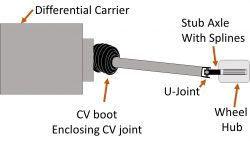How is the axle on an independent rear suspension different from solid axles?
The primary difference between independent suspension axles and solid axles is the construction, (or lack of), a housing surrounding the axle shafts joining the wheel hub and differential. Most noticeably the axle tubes of the solid axle are not present on the independent suspension axle. Instead, the axle shafts appear similar to miniature drive shafts. They have flexible joints attaching them to the differential and wheel hubs. These joints allow the movement of each wheel to be independent of the other. This means when one side of the suspension is compressed and that wheel rises, this does not impose an angular change on the entire axle (and vehicle) with regard to the other wheel. Hence, the differential and axle connected to the other wheel can remain at their current height and angle.
What kind of joints allow the axle to move independently?
Attachment of the axle to the differential can be either Universal joints (U-joints) or constant-velocity (CV) joints. With the ability to handle larger angles than U-joints, CV joints are more commonly used in axle applications. U-joints are more commonly used for the drive shaft where angular change is minimal. The most common CV-joint is the Rzeppa-type employing ball bearings contained within a grease lubricated inner and outer housing.
The importance of a correctly functioning CV-joint is clear as it provides drive from the differential side gears to the wheels. The CV-joint has a rubber cover enclosing the lubricated moving components. The rubber cover is known as the boot and protects the lubricant from getting contaminated. In its position underneath the vehicle, the joint would be exposed to large amounts of contaminants. This would impair the effectiveness of the grease and result in joint wear with eventual failure. The CV boot does fail over time and typically develops a crack allowing contaminants into the joint. This is a common issue frequently diagnosed by a clicking noise while making sharp turns. It results in the CV-joint needing replacement. However, it is possible and much cheaper to replace a CV-joint boot instead of the whole joint if you catch it in time!
In the case of the solid axle, the ends of the axle shafts have splines which slot into the hub. This transfers the drive to the wheel. It provides a solid (non-flexible) link from the side gear to the wheel hub. Due to the flexible joints on independent suspension systems, this is achieved by a separate component known as the stub axle. The stub axle has the same splines and is attached to the flexible joint on the axle shaft. See the image below for an illustration.
What is the benefit of an independent suspension over a solid axle?
The independent motion of each wheel in any direction means the ride should be more comfortable. This also leads to a better handling vehicle. The transfer of forces endured by one wheel through the differential and vehicle structure to the other wheel can causes smaller displacements to be more noticeable by the vehicle occupants. However, the more rigid structure of the solid axle means that for heavier vehicles and those designated for heavy duty applications, the solid axle can be considered more durable due to lesser joints and torque transfer points between the differential and the wheels.
Are you curious what type of suspension your vehicle has? Contact us at Houston Rebuilt Axles and we can discuss it with you. Learn what preventative maintenance your vehicle manufacturer recommends. Preventative maintenance is always cheaper than replacing components. This saves you money and keeps your vehicle reliable.

